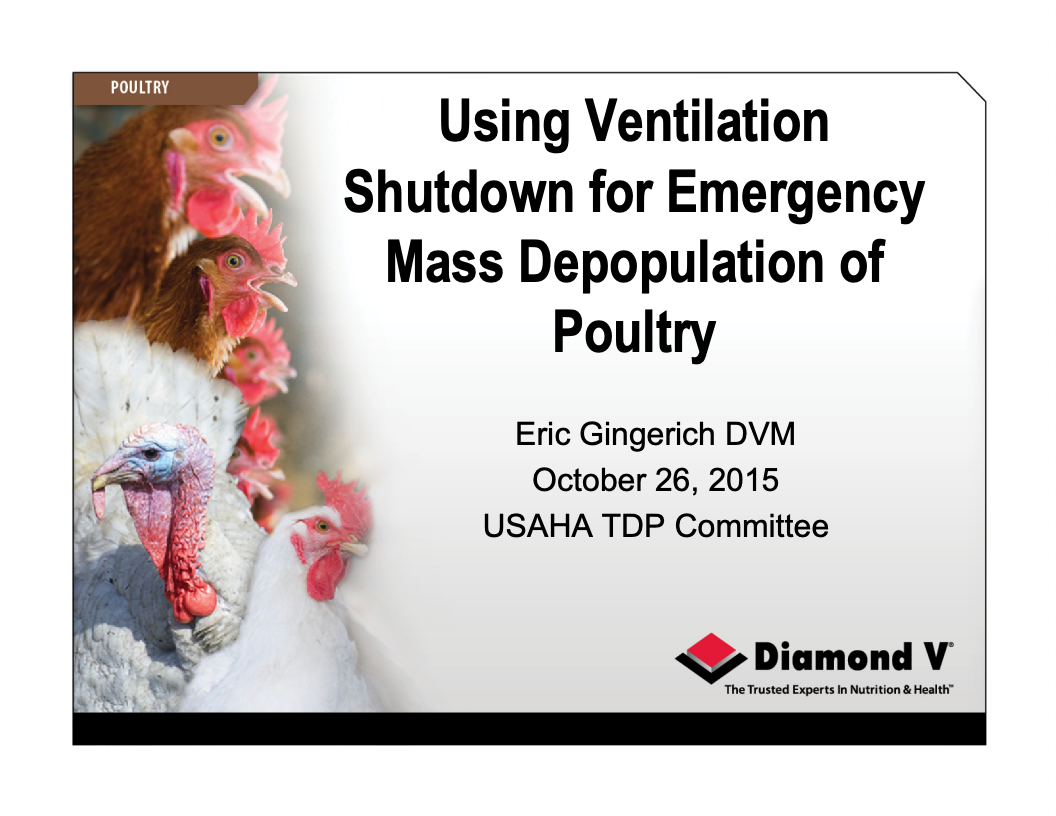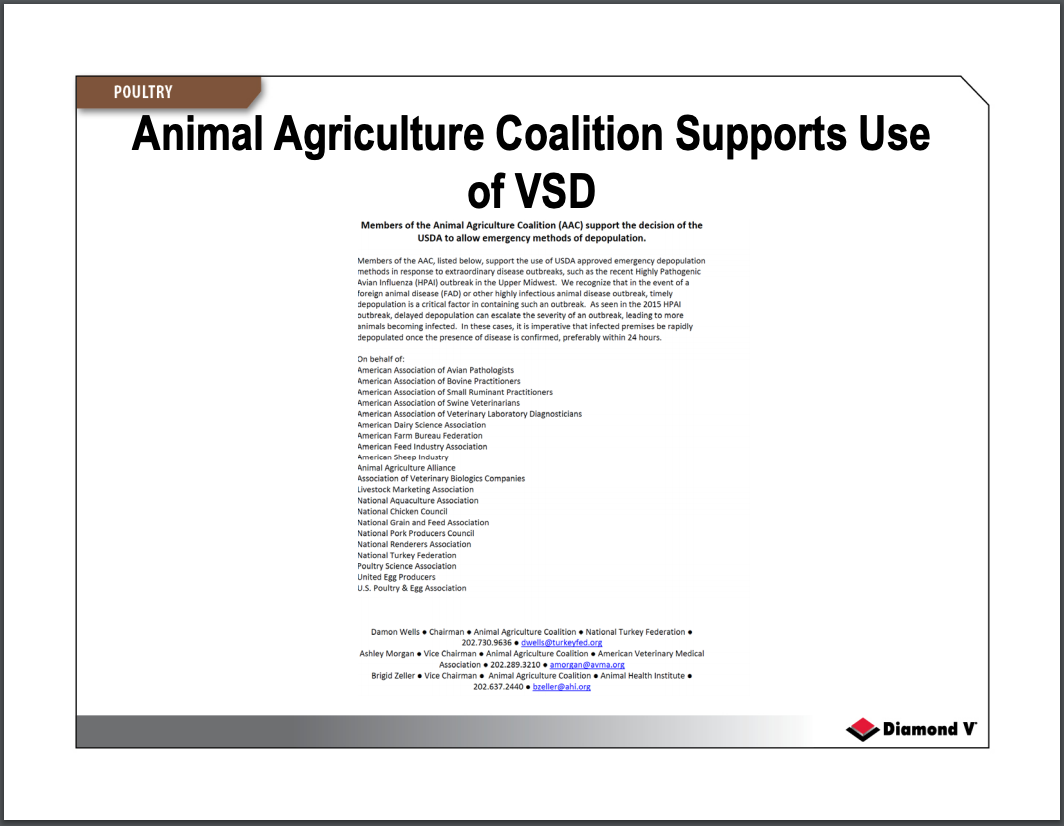
Ventilation shutdown is a brutal, painful method of animal depopulation.
These mass killings deviate from normal slaughterhouse procedures and are now being used in the pork and poultry industries.
What is Ventilation Shutdown (VSD/VSD+)?
A Poultry Veterinarian’s Definition
“Ventilation Shutdown (VSD) - Ventilation shutdown is defined as the cessation of natural or mechanical ventilation of atmospheric air in a building where birds are housed, with or without action to increase the ambient temperature. Birds die of hyperthermia.”
“VSD will only be used as a last resort if normally used methods would not meet timing criteria.”
“It is agreed that ventilation shutdown is not the ideal method for mass depopulation as it results in longer periods of time for suffering compared to other methods. The decision to use ventilation shutdown is only to be made after all other more humane methods have been considered and it has been determined that the time taken for other methods will allow the amount of virus to become excessively high and results in undue spread of the disease.”
- Eric Gingerich, DVM Poultry Expert, 2015 presentation and remarks
Ventilation Shutdown (VSD/VSD+) is exactly what it says: The pig or chicken barn is closed, all air inlets and ventilation sealed, and fans turned off. Heaters, steam, and/or gas are turned on. Body heat from the animals, combined with any added heat, raises the temperature in the house until the pigs or chickens die from hyperthermia (overheating) or suffocation from built-up gases. This typically takes hours, according to all published research.
All forms of Ventilation Shutdown were designed to be used only in severe life-threatening infectious or zoonotic disease outbreaks. It was never intended as a cost-saving method of depopulation. Livestock producers are using the AVMA Depopulation Guidelines and veterinary approval as justification for using VSD+ in situations that do not involve infections or zoonosis. The AVMA Depopulation Guidelines list several other preferred depopulation methods and the AASV lists 10 specific depopulation techniques for pigs.
According to the American Association of Swine Veterinarians (AASV), numerous variables may make the time to death of 100% of animals in the barn subject to a range of times. The AVMA cites studies (Smith, Crabtree, Bird 2008) that show pigs may remain alive up to 16 hours after VSD and experimental studies showing laying hens live an average 3.75 hours.
The age and size of the barn
The insulation of the barn
The ventilation system
Ability to adequately seal fans, louvres, doors, and windows
The number and size of animals in the barn
To increase killing efficiency, butane heaters and carbon dioxide (CO2) may be pumped into the pig or chicken barn, a procedure referred to as “Ventilation Shutdown Plus (VSD+).” The terms VSD and VSD+ are often used interchangeably, but both refer to Ventilation Shutdown and death by hyperthermia and suffocation.
The AASV recommends Ventilation Shutdown (VSD+) as a “last resort” option only if the facility can increase the temperature enough for 95% of the animals to die in under an hour. According to AVMA-cited research and swine veterinarians, not only is that unrealistic in most barns, requiring extensive and costly retrofitting to meet the standards, but VSD+ remains inhumane, causing death by overheating and suffocation.
The AVMA Guidelines for Depopulation of Animals: 2019 Edition state Ventilation Shutdown is ineffective for killing pigs, with some remaining alive after 16 hours:
“In the United Kingdom, a case study involving swine that experienced a ventilation failure event showed that 100% mortality was not achieved within that particular barn design, even after 16 hours.”
(Smith P, Crabtree H, Bird N. Perfecting the pig environment. Nottingham, England: Nottingham University Press, 2009.)
We believe the AVMA did not intend for VSD+ to be used except in extremely unusual life-threatening situations. By amending the 2019 Guidelines for Depopulation or issuing a statement, the AVMA can clarify this position to livestock and poultry producers and ensure animals are not unnecessarily subjected to the inhumane death of all forms of Ventilation Shutdown (VSD).
Even the pig and poultry industries admit
Ventilation Shutdown is ineffective and inhumane.
According to the June 9, 2020 American Association of Swine Veterinarians (AASV) - Recommendations for the Depopulation of Swine, they expect some pigs to remain alive after Ventilation Shutdown Plus.
“After VSD is complete and ventilation resumes in the facility, death can be confirmed and a backup euthanasia method applied to any remaining live animals.”
“VSD should only be used in facilities with the capability to adequately increase air temperature and relative humidity to a level that results in at least a 95% death rate in less than 1 hour.”
Research shows that meeting these AASV standards for depopulation is unlikely in most pig barns.
According to the AASV, Ventilation Shutdown Plus uses additional heat sources or CO2 in an attempt to increase mortality within a pig barn.
All forms of Ventilation Shutdown are inhumane and prolonged.
Poultry industry research concludes VSD takes at least 3.75 hours to kill chickens and adding additional heat (VSD+) takes a minimum 2 hours and does not meet the standard of 100% lethality.
“An alternative depopulation method with potential for use in the egg industry is ventilation shutdown (VSD), which uses a combination of increasing heat and carbon dioxide (CO2) levels to promote death by hyperthermia and hypoxia. This proof-of concept study was designed to evaluate the effectiveness of VSD, VSD with supplemental heat (VSDH), and VSD with CO2 (VSDCO2) as alternative mass depopulation methods in a multilevel caged system. Assessment parameters included ambient and core body temperatures, time to death, and survivability. Time to death for VSD, VSDH, and VSDCO2 were 3.75, 2, and 1.5 h, respectively. Survivability in VSD did not meet the flock depopulation standard of 100% lethality.”
Evaluation of Ventilation Shutdown in a Multi-level Caged System
2018 Journal of Applied Poultry Research
The AVMA Guidelines on Depopulation: 2019 Edition includes VSD+ despite admitting it is ineffective, potentially inhumane, and should only be used “in constrained circumstances.”
The reality is that pig and chicken farms are now using VSD plus heaters as a cheaper, less resource-intensive method of mass killing. They are using the AVMA guidelines to justify this practice.
We urge our veterinary colleagues and concerned citizens to join us in asking the AVMA to unite with other international veterinary organizations, animal welfare groups, and farmers to reject any form of VSD as a permitted form of animal depopulation.
Here’s what VSD looks like…
Excerpt from The Intercept: “IOWA’S LARGEST PORK PRODUCER, Iowa Select Farms, has been using a cruel and excruciating method to kill thousands of pigs that have become commercially worthless due to the coronavirus pandemic. As is true for so much of what the agricultural industry does, the company’s gruesome extermination of sentient animals that are emotionally complex and intelligent has been conducted entirely out of public view.
But The Intercept, as the result of an investigation by animal rights group Direct Action Everywhere, or DxE, has obtained video footage of the procedure and the resulting carnage that occurred at one of the company’s facilities in mid-May. Additionally, a whistleblower employed by Iowa Select has provided extensive details to The Intercept about the extraordinary methods now being employed to kill pigs — agonizingly and over the course of many hours — in increasingly large numbers.
What prompted both the DxE investigation and the whistleblower to come forward is Iowa Select’s recent adoption of the mass-extermination method known as “ventilation shutdown,” or VSD. Under this method, pigs are being “depopulated,” using the industry’s jargon, by sealing off all airways to their barns and inserting steam into them, intensifying the heat and humidity inside and leaving them to die overnight. Most pigs — though not all — die after hours of suffering from a combination of being suffocated and roasted to death. The recordings obtained by The Intercept include audio of the piercing cries of pigs as they succumb. The recordings also show that some pigs manage to survive the ordeal — but, on the morning after, Iowa Select dispatches armed workers to enter the barn to survey the mound of pig corpses for any lingering signs of life, and then use their bolt guns to extinguish any survivors.”
Read The Intercept article written by award-winning journalist and attorney, Glenn Greenwald.














